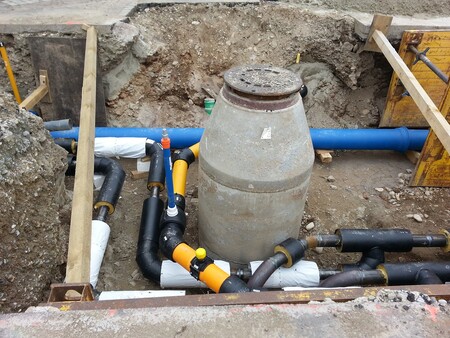HDPE FAQs: Answers to Frequently Asked Questions About HDPE Pipes

High-density polyethylene (HDPE) pipes are plastic pipes made from thermoplastic polyethylene resins. HDPE is arguably one of the most versatile types of plastic piping. It has been in use for more than 50 years, with numerous applications in various sectors worldwide, including mining, oil, and gas industry systems.
HDPE piping has come a long way since the first pipes were made. It is now in its third and fourth generation of development and demonstrates improved performance capabilities across a wide range of HDPE pipe products.
If you’re interested in using HDPE pipes, this list of FAQs should prove useful in your decision-making process.
What Are the Uses of HDPE Pipes?
HDPE pipes are highly adaptable. They have exceptionally beneficial properties, are lightweight, durable, and simple to install, as well as thermal and corrosion resistant. HDPE pipe products are also available in a variety of diameters, lengths, and wall thicknesses. As a result, they are frequently employed in pipe bursting, river crossings, and directional boring.
HDPE pipes are also widely used in commercial and residential liquid supply systems, including wastewater, chemicals, potable water, slurries, and other liquid materials.
Do HDPE and PVC Pipes Refer to the Same Thing?
HDPE and polyvinyl chloride (PVC) pipes share many similarities, such as resistance to chemical and bacterial buildups. They are used in many of the same applications, so many people are perplexed when they learn they are different. However, it is important to distinguish between the two in order to understand how each can be used most effectively.
To begin, while both are considered plastic piping, HDPE is a byproduct of petroleum, whereas PVC is manufactured using a vinyl polymer.
Second, HDPE pipe products are more resistant to corrosive materials and high-event thermal conditions. For example, HDPE can withstand over 20 years of exposure to UV rays from the sun, whereas PVC may only last three years.
Another significant difference between the two is that HDPE pipes can be installed in more ways than PVC pipes. PVC pipes can only be installed using the drop burial and open trench methods, whereas HDPE pipes can be installed using these methods as well as through the use of horizontal and directional bore techniques.
How Are HDPE Pipes and Fittings Made?
HDPE pipe manufacturing involves the use of polymerized ethylene, a by-product of petroleum alongside molds, and various additives. These include colorants, stabilizers, softeners, crosslinking agents, and others which are added to make the final HDPE pipe products and pipe fittings.
Here is an overview of the HDPE manufacturing process:
Step 1 – The HDPE resin is transferred from a storage silo into a dryer, where excess moisture in the granules is removed. After the resin has dried, it is heated until it melts.
Step 2 – The melted polyethylene resin undergoes the extrusion process. If you’re not familiar with the concept, it’s simply a process in which heated polythene resin is forced under high pressure through a bore to provide the desired shape to the finished pipe or pipe fitting.
Step 3 – Once the HDPE pipe or pipe fitting has been formed, it is sent to a cooling tank to be cooled in stages to prevent the deformation of the pipe or pipe fitting.
A Note on HDPE Thickness and Color
The density of HDPE pipe products is determined by a combination of factors, most notably, the size of the molds used.
In terms of colors, the most commonly used colorant is black, which is used to make the HDPE pipe more UV resistant. Other color variants are available on the market, but they are rarely used.
Are HDPE Pipes Safe for Use in Potable Water Applications?
HDPE pipe products are very safe for use, even for potable water applications. HDPE pipe manufacturing is governed by strict standards, and reputable manufacturers use only pressure-rated polyethylene compounds approved by regulatory bodies like the National Sanitation Foundation (NSF) International.
In addition, when compared to other similar products, HDPE piping has one of the lowest life cycle costs, boasting water conservation benefits, considerably reduced or no leakage, no loss in flow capacity over time, a reduced need for maintenance, fewer new water treatment plants and seasonal water main breaks.
Why Should You Use HDPE Pipes for Your Systems?
The service life of HDPE pipe products is conservatively estimated to be 50 years or more. This means that you will save money on replacement costs in the long run. HDPE also has a more environmentally sustainable footprint because it is chemical- and corrosion-resistant, making it a non-toxic alternative to other piping materials.
Furthermore, HDPE pipes are suitable for trenchless installation methods because they are much easier to install and handle than other traditional pipe materials such as steel. Their flexibility allows for bending them without the need for extra fittings, and they can be easily installed in various shapes and sizes over uneven terrain.
As a result, HDPE pipe products provide the ideal combination of cost efficiency, environmental friendliness, and strength, making them a viable option for a number of applications.
Got more questions about HDPE pipes or piping materials in general?
Please reach out to us at Polyfab.
We’ll be happy to answer any questions and assist you with your piping material choices.
We're here to help
Let our specialists help you find the right piping products for your needs. Get access to expert services and top-of-the-line supplies for quality, on-time, professionally delivered projects. Get in touch with the Polyfab team today.
